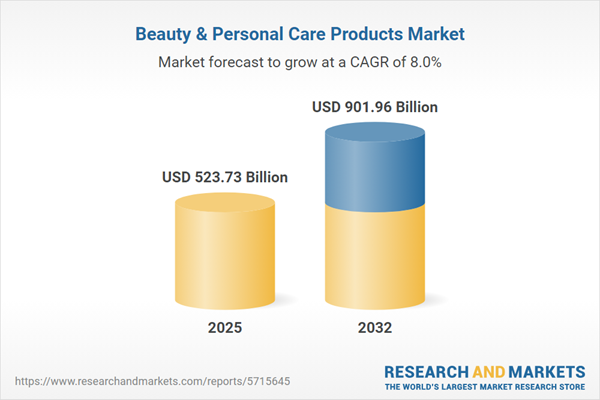Speak directly to the analyst to clarify any post sales queries you may have.
The global beauty and personal care products sector is navigating a period of dynamic transformation, as evolving consumer preferences, sustainability imperatives, and digital innovation reshape industry fundamentals for manufacturers, brands, and suppliers.
Market Snapshot: Beauty & Personal Care Products Market
The Beauty & Personal Care Products Market grew from USD 487.47 billion in 2024 to USD 523.73 billion in 2025. With a compound annual growth rate (CAGR) of 7.99%, it is projected to reach USD 901.96 billion by 2032. This growth signals rising demand for brands that integrate wellness, digital engagement, and ethical business practices, and highlights a robust landscape for innovation and scalable market entry.
Scope & Segmentation
This research provides granular coverage along product categories, consumer archetypes, and market regions, delivering actionable segmentation insights for senior decision-makers.
- Product Segments: Baby & kids personal care, including baby lotions, shampoos, and diaper rash creams; bath salts, shower gels, and soaps in the bath and body segment; diverse fragrances; hair care such as color, serums, treatments, and conditioners; makeup and cosmetics; men’s grooming products including beard and shaving care; oral care with mouthwashes and toothpaste; personal hygiene; skincare spanning body, facial, and lip care.
- Types: Covers conventional as well as organic options to reflect varying consumer priorities regarding ingredient origins and processing.
- Packaging Types: Offers analysis of bottles, pumps and dispensers, roll-ons, sachets, and tubes, considering shifts in sustainability and user convenience.
- Distribution Channels: Encompasses offline retailers and online retailers, weighed against the rising influence of digital experiences and tactile retail engagement.
- End-Users: Explores product demand and marketing nuances with children & babies, men, and women as focal groups.
- Geographic Regions: Includes Americas (North America, Latin America), Europe, Middle East & Africa (with details for Europe, Middle East, and Africa), and Asia-Pacific, calling attention to local innovation, digitalization, and unique market drivers.
- Company Analysis: Assesses strategies from major market participants such as Amorepacific Corporation, L'Oréal S.A., Unilever PLC, The Estée Lauder Companies Inc., Coty Inc., and other leading multinationals and regional specialists.
Key Takeaways
- The industry is shaped by a convergence of wellness and beauty, with consumers seeking products that deliver both visible results and holistic well-being.
- Sustainability is becoming integral, requiring reformulation, new packaging materials, and transparency across supply chains, affecting brand credibility and procurement tactics.
- Digital innovation—from AI-powered personalization to immersive virtual try-ons—serves as a central pillar of modern brand engagement strategies.
- Inclusivity and diversity in product formulation, messaging, and talent strategies are increasingly decisive for competitive positioning.
- Regional dynamics, such as digital influence in Asia-Pacific or premiumization in the Americas, require tailored, locally resonant approaches to channel development and product innovation.
Tariff Impact and Supply Chain Adaptation
New United States tariff measures on imported raw materials and packaging components are driving strategic sourcing shifts and cost management initiatives. Brands are responding by prioritizing regional procurement, innovating with alternative packaging, and leveraging robust supplier partnerships. These pressures accentuate the importance of supply chain agility, risk mitigation, and transparent consumer communication to maintain trust in a fluctuating trade environment.
Methodology & Data Sources
This report integrates comprehensive secondary research—from industry publications to regulatory filings—with direct interviews of executives, formulation specialists, and supply chain experts. Data are validated via cross-referencing multiple inputs and enriched by scenario analysis and thematic coding, ensuring precision and strategic perspective throughout.
Why This Report Matters
- Enables senior decision-makers to benchmark against competitors, anticipate shifts in consumer values, and align product pipelines with emerging trends.
- Supports commercial strategies by providing region-specific insights and technology-driven growth levers for long-term resilience and market expansion.
Conclusion
Senior leaders can leverage these insights to shape innovation, operational agility, and strategic focus in the rapidly evolving beauty and personal care products market. Engaging with this intelligence supports forward-looking decisions and enhances capacity to capture sustained competitive advantage.
Additional Product Information:
- Purchase of this report includes 1 year online access with quarterly updates.
- This report can be updated on request. Please contact our Customer Experience team using the Ask a Question widget on our website.
Table of Contents
3. Executive Summary
4. Market Overview
7. Cumulative Impact of Artificial Intelligence 2025
Companies Mentioned
The companies profiled in this Beauty & Personal Care Products market report include:- Amorepacific Corporation
- Avon Products Inc. by Natura & Co Holding S.A.
- Beiersdorf AG
- Chanel, Inc.
- Church & Dwight Co., Inc.
- Clarins Group
- Colgate-Palmolive Company
- Coty Inc.
- Dow Inc.
- Henkel AG & Co. KGaA
- Himalaya Wellness Company
- International Flavors & Fragrances Inc.
- Johnson & Johnson Services, Inc.
- Kao Corporation
- Koninklijke Philips N.V.
- L'Oréal S.A.
- Oriflame Holding AG
- PLUM GLOBAL LIMITED
- Procter & Gamble Company
- Reckitt Benckiser Group PLC
- Revlon Consumer Products Corporation
- Shiseido Company, Limited
- The Deconstruct
- The Estée Lauder Companies Inc.
- The Goodkind Co.
- The Honest Company, Inc.
- TONYMOLY USA
- Unilever PLC
- WISHCOMPANY Inc.
- YUNI Beauty
Table Information
| Report Attribute | Details |
|---|---|
| No. of Pages | 180 |
| Published | November 2025 |
| Forecast Period | 2025 - 2032 |
| Estimated Market Value ( USD | $ 523.73 Billion |
| Forecasted Market Value ( USD | $ 901.96 Billion |
| Compound Annual Growth Rate | 7.9% |
| Regions Covered | Global |
| No. of Companies Mentioned | 31 |









